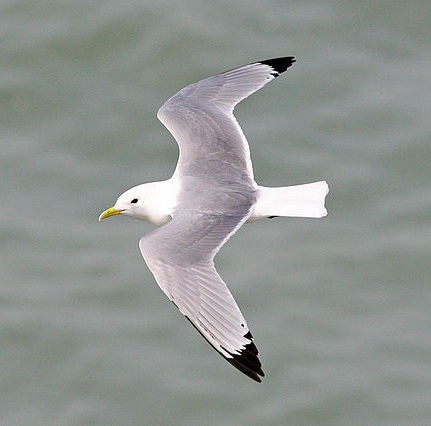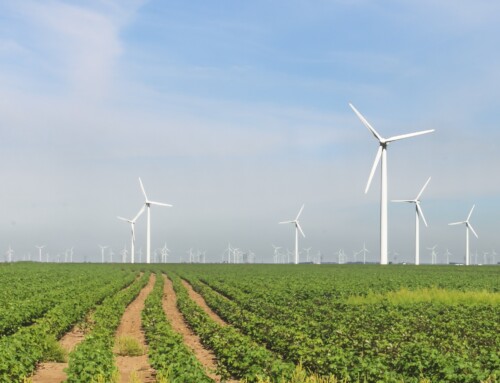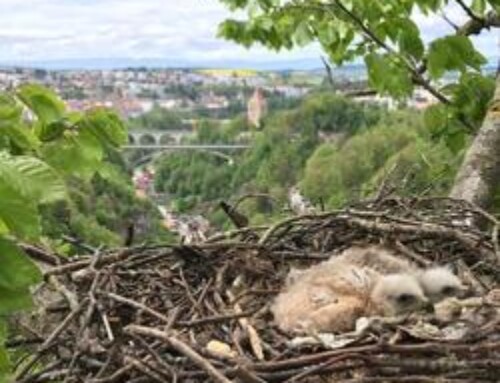
Black-legged Kittiwake © Ron Knight via Wikimedia Commons
Aspects of the offshore collision risk modelling process can be insufficiently precautionary
Based upon unpublished MSc dissertation:
Tongue, A.D.W. (2014) ‘Implications for offshore wind farm ornithological Cumulative Impact Assessment: How the manipulation of density and breeding season parameters affects the outcomes of Collision Risk Modelling’
available from the author
This reinterpretive review of offshore Environmental Impact Assessment concludes that aspects of the collision risk modelling process can be insufficiently precautionary.
In the case of UK offshore wind developments, avian collision risk at a site is usually derived via a mean density figure following two years of baseline survey, which may not reflect the importance of that site in years when seabird use is high. Estimates of collision impacts on Special Protection Area (SPA) breeding populations are influenced by definitions of the breeding season, some of which have been arguably too narrowly-defined.
Climate change is the greatest threat we face and wildlife is likely to be the earliest victim (Langston, 2010). The European Union (EU) is seeking to position itself as a global leader in the development and deployment of decarbonised, renewable energy technologies (Scrase and Gove, 2012), with the EU Renewable Energy Directive setting the target of 20% of member states’ energy consumption to be derived from renewables by the year 2020 (European Parliament and European Council, 2009).
Of all EU member states, the UK has made some of the greatest investment in marine renewable energy and has been described as the industry world leader, with almost 1 gigawatt of installed capacity, constituting as much as the rest of the world combined (Huddleston 2010; Renewable UK, n.d.).
Despite the undoubtedly serious environmental and ecological issues associated with our ongoing reliance on fossil fuels, renewable technologies can present risks to local biodiversity if they are not developed sensitively (Scrase and Gove, 2012). The construction of multiple offshore wind farms in a concentrated area has the potential to exert cumulative and in-combination impacts which may significantly affect certain seabird populations. This could potentially lead to, or contribute to, a decrease in population levels at the wider (international) scale (Poot et al., 2011)
The Environmental Impact Assessment (EIA) process for a large-scale wind energy development in EU states must include an analysis of the potential collision risk to birds. This analysis is undertaken via collision risk models, which, in the case of offshore developments, requires the input of an in-flight bird density figure. By far the most commonly-used offshore collision risk model in the UK is that devised by Band (2012).
The manner in which this density figure is derived was a key element of this research. Usually (although not always) a mean figure derived from two years of baseline surveys is used. However, it is arguable that mean densities are not accurately representative and are therefore insufficiently precautionary. This may serve to compromise any attempt at wider Cumulative Impact Assessment as the number of offshore wind farms increases. This research also raises more fundamental questions regarding the central role of density for collision risk modelling purposes. A second area of concern is the length of time accorded to species’ breeding seasons, which may influence the impacts attributable to any particular Special Protection Area (SPA) populations of that species.
In this research, comparisons and analyses were made of the collision risk implications of differences in the expression of bird density and of the definition of breeding seasons relating to three exemplar taxa (Northern Gannet Morus bassanus, Lesser black-backed Gull Larus fuscus and Black-legged Kittiwake Rissa tridactyla) across a total of six large (100-plus turbine) proposed wind farms in the UK section of the southern North Sea. All data used were extracted from publically-available EIA documentation, available either through the Crown Estate’s Marine Data Exchange for projects which have completed the planning process or the National Infrastructure Planning Portal for those sites currently in the planning application process.
In order to aid comparison of collision risk outputs across the different developments, site-specific day-time aerial density figures were inputted into the Band (2012) offshore collision risk model macros-enabled spreadsheets using standardised parameters, for example, relating to species-specific morphometic and behavioural details, but utilising a range of site-specific information, including site latitude, proposed number of turbines and a large array correction (derived from the width of the wind farm site, in square kilometres). Collision risk estimates derived using mean densities (as formally used in the EIA process for each of these developments) were compared with those derived using peak densities.
Relative stochasticity (randomness) of bird densities between two baseline survey years is arguably a significant issue affecting the derivation of density estimates. For example, at one site, population estimates of Black-legged Kittiwakes and Northern Gannets varied considerably between the two baseline survey years of 2010 and 2011, with the result that the collision risk estimates of both species in 2011 were almost double what they were in 2010. Maclean et al. (2013) noted that seabird numbers fluctuate greatly at any given location and Barton et al. (2012) recorded ‘moderate’ to ‘large’ annual variations in annual species abundance at the proposed Neart na Gaoithe offshore wind farm, which they attributed to differences in food availability caused by hydrodynamic features and weather. These variations in density may also serve to complicate assessments of the post-construction impacts of wind farms on seabird populations (Barton, et al. 2012, Maclean et al., 2013).

KEY:
Dark grey bars: CRM outputs using mean monthly in-flight densities over two-year baseline
Pale grey bars: CRM outputs using peak monthly in-flight densities over two-year baseline
Figure 1 displays differences in monthly collision risk modelling outputs derived via mean and peak densities across the two standard baseline survey years for Black-legged Kittiwake for the six wind farms in question. Clear disparities between peak and mean monthly densities can be seen, produced by a notable variation in density between both years. This raises questions about the efficacy of using mean densities in the calculcation of offshore collision risk, at least over a two-year baseline survey period. The use of mean density may mask peaks, effectively scoping birds out of the EIA process.
Disparities were found between some EIA definitions of the breeding seasons (or length of colony occupation) of SPA populations and those given for the same species in the standard ornithological literature. Although levels of flight activity and central-place foraging can vary according to the stage of the breeding season (as demonstrated by Robertson et al., 2014), it is of concern that certain offshore wind farm Environmental Statements give the length of the Northern Gannet breeding season as being from May to August, while Nelson cited in Birdguides n.d. (Birds of the Western Palearctic interactive) asserts that colonies may be occupied from January through to November. This has implications in terms of how and whether birds recorded at certain times of the year during baseline surveys should be apportioned to a particular SPA for collision risk modelling purposes.
Recommendations for future research include comparisons of EIA and collision risk modelling practice in the UK with that undertaken elsewhere. This could include neighbouring North Sea countries, but could equally be widened to consider practice undertaken in other states where offshore renewable energy development is advancing, such as China (Wu et al., 2014) or where it is predicted to do so, such as the United States (Dumaine, 2013). Since existing models utilise density as a key parameter, it may be important to analyse the relative merits and de-merits of assigning greater importance to different parameters as part of the development and evolution of collision risk models for the offshore environment.
Acknowledgements
I owe a debt of gratitude to my Open University tutor Claire Appleby and my RSPB Centre for Conservation Science supervisor Dr Benedict Gove, both of whom were key sources of advice and guidance during the course of this research.
References
Band, W. (2012) Using a collision risk model to assess bird collision risks for offshore wind farms. Prepared for The Crown Estate as part of the Strategic Ornithological Support Services (SOSS) programme, project number: SOSS-02A.
Barton , C., Poot, M.J.M., Crutchfield, Z., Bloor, P. & Jackson, D. (2012) ‘Examining between-year natural variation in seabird numbers and distribution at an offshore wind farm development site’. Poster from BOU Proceedings – Marine Renewables & Birds. BOU, Peterborough. View short paper View poster
Birdguides (n.d.) Birds of the Western Palearctic interactive (BWPi) CD-Rom Version 2.0. Birdguides, London. Further information
Dumaine, B. (2013) ‘Change is in the wind’, Fortune, 19 September [Online]. View (Accessed 9 August 2014).
European Parliament and European Council (2009) Renewable Energy Directive. Brussels and Strasbourg, Official Journal of the European Union (Directive 2009/28/EC).
Huddleston, J. (ed.) (2010) Understanding the environmental impacts of offshore wind farms. COWRIE Ltd, London.
Johnston, A., Cook, A.S.C.P., Wright, L.J., Humphreys, E.M. & Burton, N.H.K. (2014) ‘Modelling flight heights of marine birds to more accurately assess collision risk with offshore wind turbines’. Journal of Applied Ecology 51: 31-41.
Langston, R.H.W. (2010). Offshore wind farms and birds: Round 3 zones, extensions to Round 1 and Round 2 sites and Scottish Territorial Waters. RSPB Research Report No. 39. RSPB, Sandy, UK.
Maclean, I.M.D., Rehfisch, M.M., Skov, H. & Thaxter, C. (2013) ‘Evaluating the statistical power of detecting changes in the abundance of seabirds at sea’. Ibis 155: 113-126. View abstract
Poot, M.J.M., van Horssen, P.W., Collier, M.P., Lensink, R. & Dirksen, S. (2011) Effect studies Offshore Wind Egmond aan Zee: Cumulative effects on seabirds: A modelling approach to estimate effects on population levels in seabirds. Bureau Waardenburg bv, Culemborg.
Renewable UK (n.d.) Offshore Wind: Offshore Wind Energy Figures [Online]. View. (Accessed 1 August 2014).
Robertson, G.S., Bolton, M. & Monaghan, P. (2014) ‘Inter- and intra-year variation in foraging areas of breeding kittiwakes (Rissa tridactyla)’. Marine Biology 161: 1973-1986.
Scrase, I. & Gove, B. (2012) ‘Meeting Europe’s renewable energy targets in harmony with nature’. In Practice 78: 7-11.
Tongue, A.D.W. (2014) ‘Implications for offshore wind farm ornithological Cumulative Impact Assessment: How the manipulation of density and breeding season parameters affects the outcomes of Collision Risk Modelling’, unpublished MSc dissertation, Open University. available from the author
Wu, J., Wang, Z.X., & Wang, G.Q. (2014) ‘The key technologies and development of offshore wind farms in China’. Renewable and Sustainable Energy Review 34: 453–462.
If you want to write about your research in #theBOUblog, then please see here.




